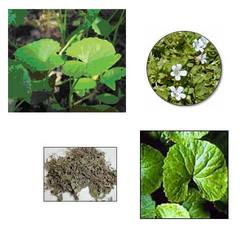NEW DELHI
- GST NO. : 07AAHPG9824B1ZW
View Mobile Number
Hydrcotyle Asiatica: (brahmi, Indian Pennywort)

Biological Name: Hydrocotyle asiatica, Centella asiatica, Bacopa monnieri
Family: Umbelliferae
Other Names: Indian Pennywort, Brahmi, Mandukparni, Brahma-manduki, Brahmibuti, Khulakudi, Gotu Kola, Karinga, Karivana, Karbrahmi, Tholkuri, Ekpanni, Kutakam, Vondelaga, Hingotu-kola.
Habitat: Brahmi belongs to perennials and is indigenous to several tropical countries, like India. It grows in waste places, gardens, and shady localities. Shoal water is the place where the plant grows, with its leaves being on the surface, and its root being under water. It can alter in its appearance reaching different stages of its growth. Where the soil is dry it produces multiple small roots, which in their turn produce red-colored long stems. The leaves are commonly 6 inches long being 1 inch wide. The plant commonly blossoms with 3-6 flowers of red color. The fruit ripens during the entire season, and as it matures, its appearance is characterized by stout pericarp.
Additional Info:
- It is laghu (light), tikta (bitter), sheet veeryam (cold) and medya (benefits the nervous system), Raktapittahara (prevents bleeding from high pitta), Raktasodhana (purifies the blood), Kusthaghna (alleviates skin diseases), Rasayana (benefits all seven tissues), Vayahsthapana (antiageing), Hrdaya (heart tonic), Nidra-janana (promotes sleep).
- Mandukaparni cures haemorrhagic diseases and heart trouble; efficacious in skin affections, polyuria, fever, dyspnoea, cough and anorexia; kasaya; subdues deranged pitta, svadurasa, svadupaka, (madhuravipaka) and hima (sheetaveerya)
Elements Applied: Every part of plant is applied in herbal medicine.
Active Components :
- Flavonoids Quercetin, astragalin; Triterpenoids Asiatic acid; Saponins Asiaticoside, brahmoside, brahminoside; Phytosterols Stigmasterol, sitosterol; Volatile oils (Williamson 2002)
- The main component responsible for Brahmi actions is triterpenoid. Triterpenoids (dubbed as saponins), including madasiatic acid, madecassoside, and asiaticoside are medicinally active components found in the herb. Saponins produce a positive effect on collagen (the element which takes part in connective tissue formation), decreasing its content when it comes to excessive scar tissue production.
- The herb also includes a strong essential oil which consists of several oils, cineole, camphor, and unknown terpene acetate. Brahmi is known to include fatty acid glycerides, numerous plant sterols like sitosterol, stigmasterol, and campesterol, as well as different polyacetylene components.
History :
- Brahmi has gained great popularity since it was first employed in Indian Ayurvedic medicine dozens of centuries ago. The herb is described in Indian medicinal scriptures of ancient times. The plant is applied thought the Indonesia islands, including Java. Chinese medicine refers to Brahmi as one of the miraculous remedies which increase vitality.
- Gotu Kola has been used as a medicine in the Ayurvedic tradition of India for thousands of years. It is listed in the historic Susruta Samhita, an ancient Indian medical text. The herb is also used by the people of Java and other Indonesian islands.
- In China, gotu kola is one of the reported "miracle elixirs of life". This was attributed to a healer named LiChing Yun who, legends say, lived 256 years by taking a tea brewed from gotu kola and other herbs. Gotu Kola is prominently mentioned in the Shennong Herbal compiled in China over 2000 years ago.
- In the nineteenth century, Gotu Kola and its extracts were incorporated into the Indian pharmacopeia, wherein addition to being recommended for wound healing, it was recommended in the treatment of skin conditions such as leprosy, lupus, varicose ulcers, eczema, and psoriasis. It was also used to treat diarrhea, fever, amenorrhea, and diseases of the female genitourinary tract. Gotu Kola was first accepted as a drug in France in the 1880's.
Used For :
- The remedy is known to rejuvenate the body, soothes the nervous system, reduces fevers, boosts metabolic rates, and induces urination.
- It acts as an alterative, tonic and it helps to improve the color of the body, maintain youth, improves memory, and mental weakness. It helps in improving speech, controls excitability and impaired brain functions and increases capacity for mental work.
- Brahmi rejuvenates the central nervous system, and is suggested as a remedy for nervous conditions, like senility, premature aging process, and epilepsy. It is believed to improve memory and mental abilities.
- The herb is especially beneficial for individuals exposed to constant stress. Brahmi is believed to nourish the brain. It is employed to relieve depression and stress, acts as anti-anxiety agent, enhance body reflexes, recover the nervous system after a breakdown, increase mental powers, and treat sterility.
- It also calms restlessness in children and is used in several mental disorders.
- It is an excellent adrenal gland stimulant, which is also applied for purifying blood and a cleansing herb for toxic substances and thus relieving skin conditions.
- Brahmi improves blood circulation. It is a cardiotonic producing a positive effect on circulatory system; it also makes capillaries and veins stronger. It has been applied for tingling in legs and hands, leg pains, and phlebitis.
- It is successfully applied for elevated blood pressure, hepatitis, urinary infections, congestive heart failure and rheumatism.
- It can mildly induce urination, eliminating membrane swellings and flushing away excess water. It promotes sore healing.
Safety: 2-4 ratti (.25-.5 gm) per day can be taken safely (Bhavaprakasha Nighantu). Exercise care. Herbs in Ayurvedic medicine are commonly mixed with other herbal medicines to reduce the toxic effect one of them may produce on the body.
Contact Us
Govind Madhav Herbal Tea
B-29-30, NEW DELHI - 110064, India
Call Us : View Mobile Number
Phone : +91-11-45615006
E-mail : govindmadhavtea@gmail.com

